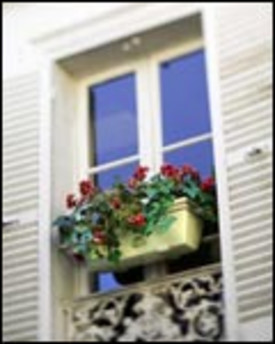 |
Many products and systems are availble to protect your home’s openings but it is critical that any product or system be both tested and approved for wind load and wind borne debris.
Unprotected standard glass windows can be penetrated easily by wind borne debris in severe windstorms allowing damaging water and wind to enter your home. Once the window glass fails, the subsequent pressurization of the structure can cause total destruction of the house.
With the exception of impact-resistant window glass, all other glass, even if it is tempered, reinforced or insulated, needs to be protected during a severe wind storm.
Shutter Your Windows
Installing storm shutters is one of the best ways to protect your home. Purchase or make storm shutters for all exposed windows, glass surfaces, French doors, sliding glass doors, and skylights.
The most common device for opening protection is the hurricane shutter system. Choices include permanent or temporary shutter systems for use on windows and skylights as well as gable end vents, sliding glass doors, exterior doors, and garage doors.
There are two types of shutter systems, permanent shutters, and temporary shutters.
Permanent shutters should be installed by trained individuals and according to the manufacturer’s specifications to ensure the shutters will perform as designed and tested. Factors to consider when choosing a shutter system are approval status, design and test results for wind and impact resistance.
Permanent shutter types include Bahamas, roll downs, accordion, awning, and colonial hinged.
Choosing a shutter style can be based on several criteria, including the building location relative to the coast and the cost and ease of operation. Ease of operation is an important factor to consider because if shutters are too hard to close, owners may not use them. If shutters cover windows on an upper floor or hard to reach location, they should be operable from the inside. Roll-down shutters are often the easiest to operate in these conditions.
Temporary shutters are designed to withstand wind borne debris impacts and wind loads during a hurricane. They are commercially available in many types of materials including steel, aluminum, and clear plastic. Temporary shutters are typically corrugated panels that come in standard widths and can be joined to cover wider openings.
 |
||||
|
||||
The mounting hardware for temporary shutter systems should be installed well before hurricane season by trained individuals according to the manufacturers specifications. Each panel should be clearly labeled to aid in quick installation, and should also bear approved labels.
Plywood Shutters the Last Resort
Covering your windows and doors with plywood should only be a last-resort alternative to actual storm shutters. Plywood that is not properly attached to your house can rip off during high winds and become a projectile that can cause serious harm to your and your neighbor’s property.
See Emergency Board Up for detailed instructions about building plywood shutters.
The Myth of Masking Tape
Many people still believe they can use masking tape to protect their windows when a hurricane is on its way. This is a myth. Imagine a mail box that has been ripped from the ground, post and all, by a 120 mph wind gust. A dangerous projectile will not even slow down as it passes through masking tape. Windows are best protected with impact-resistant glass or hurricane shutters.




























